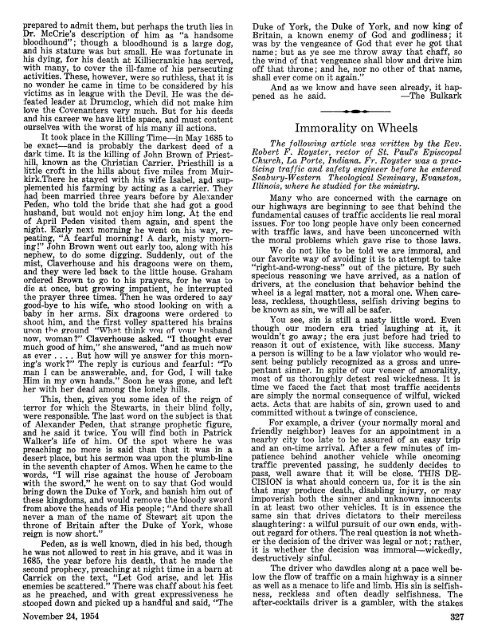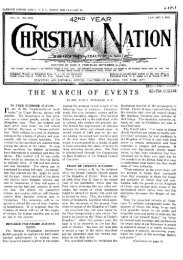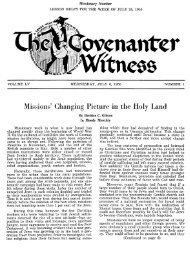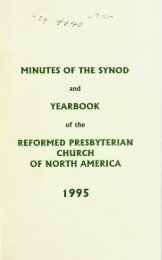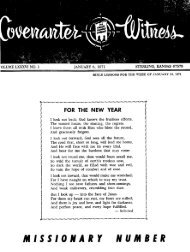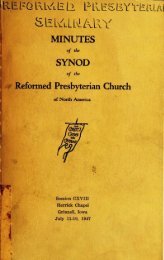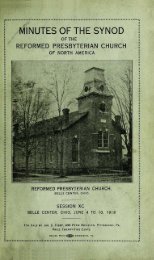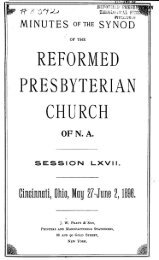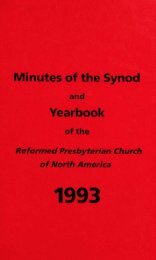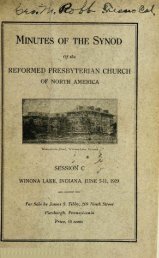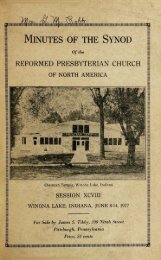Covenanter Witness Vol. 53 - Rparchives.org
Covenanter Witness Vol. 53 - Rparchives.org
Covenanter Witness Vol. 53 - Rparchives.org
Create successful ePaper yourself
Turn your PDF publications into a flip-book with our unique Google optimized e-Paper software.
woman?"work?"sword,"short."scattered."prepared to admit them, but perhaps the truth lies inDr. McCrie's description of him as "a handsomebloodhound"; though a bloodhound is a large dog,and his stature was but small. He was fortunate inhis dying, for his death at Killiecrankie has served,withmany, to cover the ill-fame of his persecutingactivities. These, however, were so ruthless, that it isno wonder he came in time to be considered by hisvictims as in league with the Devil. He was the defeated leader at Drumclog, which did not make himlove the <strong>Covenanter</strong>s very much. But for his deedsand his career we have little space, and must contentourselves with the worst of his many ill actions.be exactIt took place in the Killing Timein May 1685 toand is probably the darkest deed of adark time. It is the killing of John Brown of Priesthill, known as the Christian Carrier. Priesthill is alittle croft in the hills about five miles from Muirkirk.Therehe stayed with his wife Isabel, and supplemented his farming by acting as a carrier. Theyhad been married three years before by AlexanderPeden, who told the bride that she had got a goodhusband, but would not enjoy him long. At the endof April Peden visited them again, and spent thenight. Early next morning he went on his way, repeating, "A fearful morning! A dark, misty morning!"John Brown went out early too, along with hisnephew, to do some digging. Suddenly, out of themist, Claverhouse and his dragoons were on them,and they were led back to the little house. Grahamordered Brown to go to his prayers, for he was todie at once, but growing impatient, he interruptedthe prayer three times. Then he was ordered to saygood-bye to his wife, who stood looking on with ababy in her arms. Six dragoons were ordered toshoot him, and the first volley spattered his brainsunon t>e ground "What think vou of vour husbandnow, Claverhouse asked. "I thought evermuch good of him," she answered, "and as much nowas ever .... But how will ye answer for this morning's The reply is curious and fearful: "Toman I can be answerable, and, for God, I will takeHim in my own hands." Soon he was gone, and lefther with her dead among the lonely hills.This, then, gives you some idea of the reign ofterror for which the Stewarts, in their blind folly,were responsible. The last word on the subject is thatof Alexander Peden, that strange prophetic figure,and he said it twice. You will find both in PatrickWalker's life of him. Of the spot where he waspreaching no more is said than that it was in adesert place, but his sermon was upon the plumb-linein the seventh chapter of Amos. When he came to thewords, "I will rise against the house of Jeroboamwith the he went on to say that God wouldbring down the Duke of York, and banish him out ofthese kingdoms, and would remove the bloody swordfrom above the heads of His people ; "And there shallnever a man of the name of Stewart sit upon thethrone of Britain after the Duke of York, whosereign is nowPeden, as is well known, died in his bed, thoughhe was not allowed to rest in his grave, and it was in1685, the year before his death, that he made thesecond prophecy, preaching at night time in a barn atCarrick on the text, "Let God arise, and let HisThere was chaff about his feetenemies beas he preached, and with great expressiveness hestooped down and picked up a handful and said, "TheNovember 24, 1954Duke of York, the Duke of York, and now king ofBritain, a known enemy of God and godliness; itwas by the vengeance of God that ever he got thatname; but as ye see me throw away that chaff, sothe wind of that vengeance shall blow and drive himoff that throne ; and he, nor no other of that name,again."shall ever come on itAnd as we know and have seen already, it happened as he said.The BulkarkImmoralityon WheelsThe following article was written by the Rev.Robert F. Royster, rector of St. Paul's EpiscopalChurch, La Porte, Indiana. Fr. Royster was a practicing traffic and safety engineer before he enteredSeabury-WesternTheological Seminary, Evanston,Illinois, where he studied for the ministry.Many who are concerned with the carnage onour highways are beginning to see that behind thefundamental causes of traffic accidents lie real moralissues. For too long people have only been concernedwith traffic laws, and have been unconcerned withthe moral problems which gave rise to those laws.We do not like to be told we are immoral, andour favorite way of avoiding it is to attempt to take"right-and-wrong-ness"out of the picture. By suchspecious reasoning we have arrived, as a nation ofdrivers, at the conclusion that behavior behind thewheel is a legal matter, not a moral one. When careless, reckless, thoughtless, selfish driving begins tobe known as sin, we will all be safer.You see, sin is still a nasty little word. Eventhough our modern era tried laughing at it, itwouldn't go away; the era just before had tried toreason it out of existence, with like success. Manya person is willing to be a law violator who would resent being publicly recognized as a gross and unrepentant sinner. In spite of our veneer of amorality,most of us thoroughly detest real wickedness. It istime we faced the fact that most traffic accidentsare simply the normal consequence of wilful, wickedacts. Acts that are habits of sin,committed without a twinge of conscience.grown used to andFor example, a driver (your normally moral andfriendly neighbor) leaves for an appointment in anearby city too late to be assured of an easy tripand an on-time arrival. After a few minutes of impatience behind another vehicle while oncomingtraffic prevented passing, he suddenly decides topass, well aware that it will be close. THIS DECISION is what should concern us, for it is the sinthat may produce death, disabling injury, or mayimpoverish both the sinner and unknown innocentsin at least two other vehicles. It is in essence thesame sin that drives dictators to their mercilessslaughtering: a wilful pursuit of our own ends, without regard for others. The real question is not whether the decision of the driver was legal or not ; rather,it is whether the decision was immoral wickedly,destructively sinful.The driver who dawdles along at a pace well below the flow of traffic on a main highway is a sinneras well as a menace to life and limb. His sin is selfishness, reckless and often deadly selfishness. Theafter-cocktails driver is a gambler, with the stakes327


